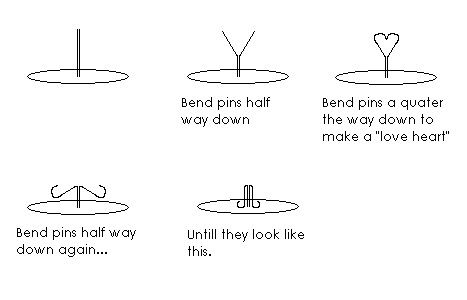For artists and collectors sponsored by Intercal...your mohair supplier and Johnna's Mohair Store
I came across this illustration I did a while ago and thought someone reading or lurking here might find it useful. It shows the two different methods for turning down the ends of cotter pins.

Please note that the drawing, above, illustrates how to turn down the pin ends by showing an oversimplified joint mechanism. You'll see that I drew only a single disk, surrounded on both sides by washers, with the turndown method highlighted... but absent any actual "bear" parts of any kind.
Obviously, in a real bear, there would be TWO disks, and TWO layers of fabric present, where body meets limb. Like this:

This particular illustration shows a "wobble" joint, with two cotter pins joined up at the loop. Obviously, you could use ONE cotter pin, with loop inside limb, and crown or snail curls inside body, for a firmer, tighter joint.
Hi Shelli, I have turned thousands of cotter pins on joints and I find I prefer to turn it the snail way. At first I would mess up and sometimes even have to start again but I'm sure I could turn a cotter pin in my sleep now! :D
Thanks for the illustrations I'm sure it will really help the people that are just starting out with bear making.
Jane
Hi Shelli and Jane,
I'm using cotter pin for my bears now
and I tune the pin in snail way. I never knew about the crown joint :rolleyes:
Shelli, Thanks for the illustrations  I'm learning new thing everyday now...:cool:
I'm learning new thing everyday now...:cool:
Hugs/Marie
I have done both methods and found that the snail way is much, much easier (after many blisters, I might add!!!)
The snail way is faster but I found the crown joint to be tighter...
I found a way to make the snail joints tighter thoif they get too splayed out ....just take vise grips and place them on the outside curls and gently squeeze...it pulls the snails closer together while at the same time it seems to push down against the disc....give it a try....Winney
Great tip, Winney! So simple, but it's never explained anywhere else. It certainly would keep those snail curls from unfurling with just that extra crimp to bind them together.
Thanks!
Yup...I found that one out by frustration...mother of invention , he, he, Oh yes..., do this slowly and if the snail scave in sideways a a bit just reposition your vise grips ...straighten the snails out then continue on...Winney
Oops..or use your small channel locks/vise grips to straighten those snails out..Winney
I'm a snail girl for the arms and head, but prefer to use nut n bolt joints for the legs to give strength and prevent them splaying over time.
Hi Shelli, I would love to see the difference in the two joints. I realize this is an older post, but I seem to only know one way to do this. Can you repost the pictures? Or is it just my silly browser showing "Seller's Image No Longer Online"?
Thanks!!
I've only every used the crown way!
If you go half way down the pin, bend them away from each other, Then half way down the top part of the pin between the bend and make a love heart shape, Then where you bend it first, bend it all the way down to touch the joint, Works great EVERY time. I included an illistration

If you want them explained more clearly, I can try :)
Richy~
Richy, thankyouverymuch!!! The picture pulls all the other posts together. And all the other tips are more helpful. 
Richy, thanks so much! I missed Annnik's question about the images. Your illustration and explanation are perfect; much appreciated!
To complete the explanations here... In the "snail method", you grasp the very tip of the cotter pin (both sides) with pliers or a cotter key, and then roll the pin down in a spiral, so it looks like a snail shell, until it meets the disk at the bottom.
The crown joint method is much sturdier, I find, than the snail method.
i used the 'snail method' first, but got frustrated with not being able to get them tight enough especially since my bears are small (trying to that method in such a tiny space was really hard). i saw the 'crown method' in a book i got and i love doing it that way! i can get the cotterpin nice & tight that way!